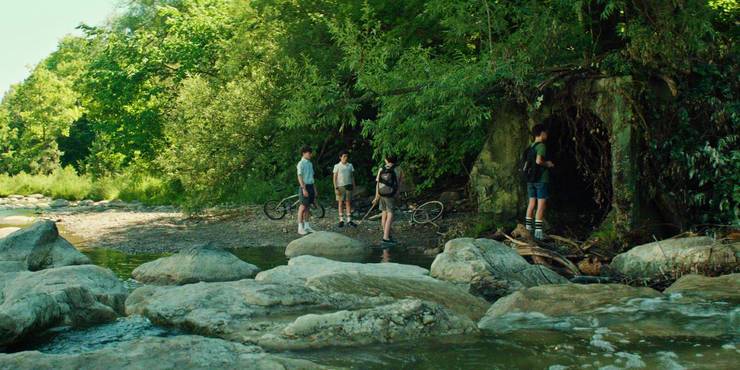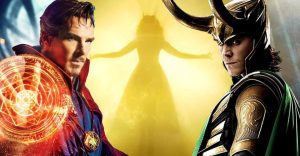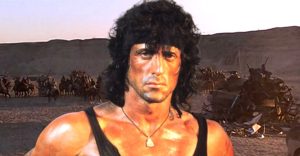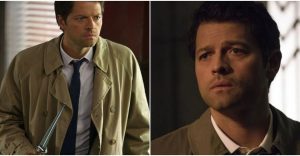Everything IT Chapter One Changed About Mike Hanlon’s Backstory

IT: Chapter One tells the origins of The Losers Club, but changes a lot of details from the novel, especially when it comes to the character of Mike Hanlon. The 2017 film, directed by Andy Muschietti, is based on Stephen King’s famous novel of the same name. Rather than adopt the strategy of cutting between the adult and childhood timelines of the characters, as is done in the book and the 1990 miniseries, IT: Chapter One focuses solely on the Losers Club as they grow up and face It— also known as Pennywise the Dancing Clown—for the first time.
Mike Hanlon is a later addition to the Losers Club, befriending the group after running into them in their favorite hangout, The Barrens, while being chased by racist bullies. When the Losers help protect him, Mike joins the fold, sharing his experiences with his new friends and joining them in the fight against Pennywise. But there are some key differences between IT the film and the original novel, especially regarding Mike’s backstory. As is the case with most adaptations, the skeletal plot remains, but many details of Mike’s life are rearranged and altered, mostly in an effort to distill Stephen King’s massive work into a two hour film.
One hallmark of Mike’s character is his choice, in adulthood, to remain in Derry, waiting for It to return, vowing to call the Losers back home to honor the promise they made as children. This decision, however, is strongly linked to factors from his backstory that are changed for the film, and the influence of these changes can be seen in It: Chapter Two, where Mike’s dedication to stopping Pennywise is re-framed more as an obsession. In the novel, Mike is definitely consumed by his work, but his dedication comes from a different place, connected to fonder memories. It is no surprise that the IT films shave down on some character’s development and backstory; not everything can make it into the film. Let’s take a look at what IT: Chapter One changed about Mike Hanlon.
Mike Isn’t Raised By His Grandfather In The Novel

Though he grows up with two parents in the novel, Mike is raised by his grandfather in Muschietti’s films. The two work together on the family farm, where Mike is troubled by the routine execution of sheep. This is a key motif throughout the film, chiefly because the bolt gun they use on the farm becomes Mike’s primary weapon when facing off with Pennywise. Furthermore, Mike’s grandfather uses the sheep as a metaphor, explaining the dangers of the world to Mike in a somewhat harsh way. It’s effective, and lends itself well to the idea that adults (especially those in Derry) are cold and often completely absent when children need them.
In the novel, however, Mike has a very close and loving relationship with his parents, especially his father. Though Mike still works on the family farm, his father is much gentler in terms of the lessons he teaches to Mike. This comes out especially when his father teaches him about what he must face as a young black man in a small, mostly white town. The issue of racism is addressed in the film, but mostly as it exists as a form of hatred in Derry. Mike’s own relationship to racism isn’t explored as fully as it is in the novel, even though his grandfather’s advice can certainly be taken in that context. While it would not have served the film as well as it does the novel, Mike’s relationship with his father is quite beautiful, marked by a tenderness most of the other Losers don’t get at home. Mike’s father is a very involved parent, and teaches Mike a great deal about Derry’s history, which informs Mike’s life as an adult quite significantly.
Mike Researches The History of Derry, Not Ben

Mike spends his adulthood working on his own history of Derry in the novel, but in IT: Chapter One, it is Ben Hanscom who does research for the gang. It’s a logical enough shift, given Ben’s love of the library in the novel, but it does take away a big part of Mike’s story. Mike learns much of what he knows from his father, and in doing away with that relationship, the film removes his hypothetical access to that information, leaving Ben as the next in line to trace Pennywise’s many appearances throughout the town’s history. Ben is also missing a key piece of his story from the novel — his skill for architecture is discovered when the Losers build a dam in the Barrens. So, rather than invent new stories for both characters, giving the history connection to Ben was a pragmatic choice for the film.
However, the choice to give the history plot to Ben meant that IT: Chapter Two needed to change some of the motivation behind Mike’s decision to remain in Derry. Mike’s fascination with the history of Derry is informed not only by his experiences with Pennywise, but also by his connection to his father. In the novel, he continues his father’s research (which consists of newspaper clippings of the major accidents Pennywise incites every 27 years, photos and illustrations of Derry, many of which capture Pennywise, confirming his reappearances) by pursuing historians of Derry and individuals who survived significant but undocumented events. Without the inclusion of his father, Mike has no background research to go on, which is why his search for Pennywise is portrayed as more disorganized and troubled.
The Form Pennywise Takes to Scare Mike

One final major change IT: Chapter One makes from the original novel is the form that Pennywise takes to terrorize Mike. This is perhaps the most significant change, which understandably prompts the others discussed above. In the film, when the Losers meet to discuss what is happening in Derry, Mike recounts the house fire that took his parents’ lives, recalling the harrowing memory of them pounding on the door, trying to reach him. It is this that Pennywise recreates to frighten Mike. While the visuals are upsetting on their own, it is in this scene that the audience truly understands the root of Mike’s fear. In another scene, Henry Bowers tells Mike that he wishes he could have started the house fire himself. Henry Bowers bullies all of the Losers, but consistently targets Mike more violently than the others. Mike’s fear is deeply complex, tying together the trauma of losing his parents and the trauma of the violent racism he is forced to survive.
Mike’s fear in the novel wouldn’t necessarily translate to a contemporary audience, and the confrontation of the more timely reality of racism and the universal pain of loss transcends any time period. Because the novel is set in both the 1950s and the 1980s, some of the horror references were outdated by the time the film was released in 2017. In the novel, Pennywise accosts Mike in the form of a giant bird-like monster, inspired by Mike’s fear of the titular character from the 1956 film Rodan. Though readers in 1986 may have recognized this character, audiences in 2017 might not have understood what is now a more obscure reference. In the end, though, the choice to confront Mike’s lasting trauma rather than a fear that he will likely outgrow helps to anchor IT: Chapter One in reality, allowing viewers to forge an emotional connection with the characters in its more limited timespan.
While the changes made to Mike Hanlon’s backstory in IT: Chapter One serve the film well, they do incur some overall changes to Mike’s character. He is, perhaps, slightly less composed in IT: Chapter Two, where Pennywise taunts him in regards to his research by calling him a madman. However, the essence of Mike’s character is not lost or compromised, as his curious mind, good heart, and determination are still ever-present. The IT films work to adapt an immense story for a different time period, and cuts to material from the novel are unavoidable. However, the fact that the characters of IT still translate after many significant changes is a testament to the strength of both the films and Stephen King’s original novel.
About The Author

















